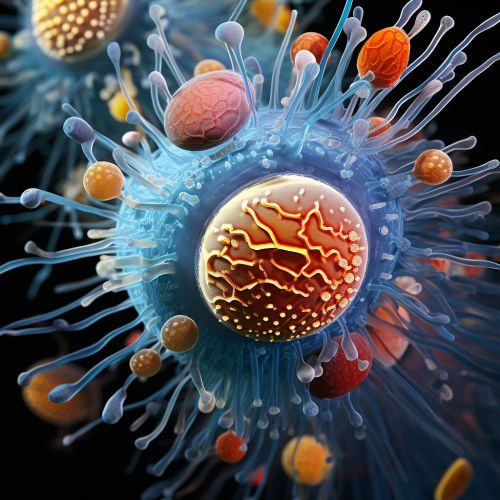Cell Biology
Introduction
Cell biology, also known as cytology, is a branch of biology that studies the different structures and functions of the cell, which is the basic unit of life. Cell biology is concerned with the physiological properties, metabolic processes, signaling pathways, life cycle, chemical composition and interactions of the cell with their environment. This is done both on a microscopic and molecular level as it encompasses prokaryotic cells and eukaryotic cells. Knowing the components of cells and how cells work is fundamental to all biological sciences; it is also essential for research in bio-medical fields such as cancer, and other diseases.


History of Cell Biology
The study of cells is done on a microscopic level, however, the details of cell biology can be traced back to the 1665 work of Robert Hooke's Micrographia, which described the structure of cork as a structure of tiny, box-like cells. The term "cell" was coined by Hooke, deriving from the Latin cellula, a small room. The idea that cells were separate entities was proposed by Antonie van Leeuwenhoek in the 1670s. He was the first to observe single-celled organisms, now known as microorganisms, using a microscope of his own design.
Cell Structure
Cells are the basic building blocks of life and make up all living organisms. There are two types of cells: prokaryotic and eukaryotic. Prokaryotic cells are usually single-celled and smaller than eukaryotic cells. Eukaryotic cells are usually found in multicellular organisms but can also exist as single-celled organisms.
Prokaryotic Cells
Prokaryotic cells are the simplest form of living cells and are believed to be the first type of cells to evolve. They are characterized by the lack of a nucleus and other membrane-bound organelles. They have a single, circular chromosome located in a region of the cell called the nucleoid.
Eukaryotic Cells
Eukaryotic cells are more complex and are found in plants, animals, fungi, and protists. They are characterized by the presence of a nucleus, where the cell's DNA is stored, and other membrane-bound organelles such as mitochondria, the endoplasmic reticulum, and the Golgi apparatus.
Cell Functions
Cells perform a variety of functions necessary for the survival of an organism. These include metabolism, protein synthesis, and cell division.
Metabolism
Metabolism is the set of life-sustaining chemical reactions in organisms. The three main purposes of metabolism are: the conversion of food to energy to run cellular processes; the conversion of food/fuel to building blocks for proteins, lipids, nucleic acids, and some carbohydrates; and the elimination of nitrogenous wastes.
Protein Synthesis
Protein synthesis is the process in which cells make proteins. It involves transcription (where a messenger molecule is created from DNA) and translation (where the messenger molecule is used to create the protein).
Cell Division
Cell division is the process by which a parent cell divides into two or more daughter cells. It is an essential process in reproduction, growth, and repair in organisms.
Cell Biology Techniques
There are several techniques used in the field of cell biology. These include microscopy, cell culture, and molecular biology techniques.
Microscopy
Microscopy is the technical field of using microscopes to view objects that are not visible to the naked eye. There are different types of microscopy including light microscopy, electron microscopy, and scanning probe microscopy.
Cell Culture
Cell culture is the process by which cells are grown under controlled conditions. This technique is used in cell biology research to study the physiology of cells, their response to drugs, the effects of toxic compounds, and the process of cell division and differentiation.
Molecular Biology Techniques
Molecular biology techniques are methods used to study the molecular and cellular aspects of biology. These include DNA sequencing, polymerase chain reaction (PCR), gel electrophoresis, and blotting techniques.
